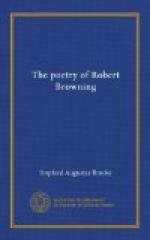For I wake in the grey dewy
covert, while Hebron upheaves
The dawn struggling with night
on his shoulder, and Kidron retrieves
Slow the damage of yesterday’s
sunshine.
Then, at the end of the poem, Browning represents all Nature as full of emotion, as gathered into a fuller life, by David’s prophecy of the coming of immortal Love in Christ to man. This sympathy of Nature with humanity is so rare a thought in Browning, and so apart from his view of her, that I think he felt its strangeness here; so that he has taken some pains to make us understand that it is not Nature herself who does this, but David, in his uplifted inspiration, who imputes it to her. If that is not the case, it is at least interesting to find the poet, impassioned by his imagination of the situation, driven beyond his usual view into another land of thought.
There is one more thing to say in closing this chapter. Browning, unlike Tennyson, did not invent his landscapes. He drew directly from nature. The landscapes in Pauline and Sordello, and in the lyrical poems are plainly recollections of what he has seen and noted in his memory, from the sweep of the mountainous or oceanic horizon to the lichen on the rock and the painted shell on the seashore. Even the imaginative landscape of Childe Roland is a memory, not an invention. I do not say he would have been incapable of such invented landscape as we find in Oenone and the Lotos-Eaters, but it was not his way to do this. However, he does it once; but he takes care to show that it is not real landscape he is drawing, but landscape in a picture. In Gerard de Lairesse, one of the poems in Parleyings with Certain People, he sets himself to rival the “Walk” in Lairesse’s Art of Painting, and he invents as a background to mythological or historic scenes, five landscapes, of dawn, morning, and noon, evening and falling night. They may be compared with the walk in Pauline, and indeed one of them with its deep pool watched over by the trees recalls his description of a similar pool in Pauline—a lasting impression of his youth, for it is again used in Sordello. These landscapes are some of his most careful natural description. They begin with the great thunderstorm of dawn in which Prometheus is seen riveted to his




